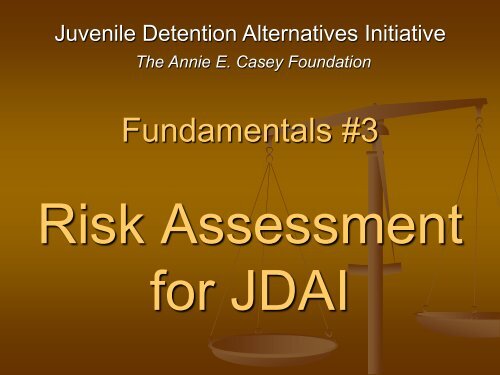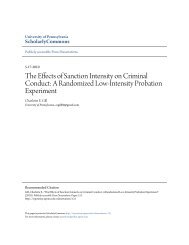Detention Risk Screening Instruments - JDAI Helpdesk
Detention Risk Screening Instruments - JDAI Helpdesk
Detention Risk Screening Instruments - JDAI Helpdesk
Create successful ePaper yourself
Turn your PDF publications into a flip-book with our unique Google optimized e-Paper software.
Juvenile <strong>Detention</strong> Alternatives Initiative<br />
The Annie E. Casey Foundation<br />
Fundamentals #3<br />
<strong>Risk</strong> Assessment<br />
for <strong>JDAI</strong>
<strong>Risk</strong> Factor Ranking<br />
! Turn to <strong>Risk</strong> Factors in your workbooks<br />
! Work individually to rank the factors to<br />
consider in deciding who goes into secure<br />
detention in order of importance<br />
! Number the items 1-15 with no duplicates<br />
! #1= Greatest Importance<br />
! #15= Least Importance
Small group discussion<br />
Think about your answers to the following questions regarding your<br />
home community. Then discuss your responses with the people at<br />
your table.<br />
! If you gave this list of risk factors to the people who make the<br />
decisions for your detention facility, would they all agree on the<br />
priorities? If not, who has the greatest influence or final say in<br />
whether a youth is detained?<br />
! What difficulties has your community experienced in matching<br />
risks with appropriate security levels? (For example, is there a<br />
gap in the continuum of custody levels that forces lower risk<br />
youth into more secure custody?)<br />
! How satisfied are you with how detention decisions are made in<br />
your community?
Objectives<br />
In this module, participants w ill:<br />
! Link RAI to detention intake decisions and<br />
the need for a continuum of detention<br />
alternatives<br />
! Identify risk-related criteria for decisionmaking<br />
! Receive an overview of the process of risk<br />
assessment and begin identifying w hat<br />
they need to do<br />
! Identify know n and potential pitfalls in<br />
risk assessment
<strong>JDAI</strong> <strong>Risk</strong> Assessment<br />
<strong>Instruments</strong> (RAI) Measure:<br />
" Re-offending pending court<br />
" FTA pending court<br />
" What about risk of harm to self?
<strong>JDAI</strong> <strong>Instruments</strong><br />
" Triage classification tools -- used to<br />
structure detain/release decisions<br />
" Point scale instruments<br />
" <strong>Risk</strong> factors, decision scales<br />
" Stakeholder consensus method<br />
" Hybrids of policy making and prediction<br />
science<br />
" Validated by overall results
RAI Construction<br />
1) Review RAI models & select basic format<br />
2) Design offense factor<br />
3) Design delinquency history factor(s)<br />
4) Design aggravation & mitigation factors<br />
5) Design the Decision or Outcome Scale<br />
6) Identify Special/Mandatory Cases<br />
7) Establish override procedures for the RAI<br />
8) Final formatting and adopt for testing
RAI Decision Making<br />
#Short or long format<br />
#Review RAI models from other sites<br />
#Relation to automation & computer<br />
systems<br />
#Statewide instruments: one for all sites?
Offense Factor Tips<br />
" Set serious/violent crimes at cutoff score<br />
" Set mid-level felonies at half the detention cutoff<br />
score<br />
" Misdemeanors – 1 to 3 points<br />
" Probation violations:<br />
" Zero points?<br />
" Decide on how these cases will be handled at start
Offense Factor Example<br />
Offense <strong>Risk</strong> Factors from the<br />
Virginia <strong>Detention</strong> <strong>Risk</strong> Assessment Instrument<br />
(<strong>Detention</strong> cutoff score is 15 points)<br />
Most Serious Alleged Offense<br />
Category A: Felonies against persons 15<br />
Category B: Felony weapons and felony narcotics distribution 12<br />
Category C: Other felonies 7<br />
Category D: Class 1 misdemeanors against persons 5<br />
Category E: Other Class 1 misdemeanors 3<br />
Category F: Violations of probation/parole 2<br />
Total Offense Points 44
Delinquent History Factors<br />
" Prior offenses: Adjudications vs. arrests<br />
" Time limits on prior offenses<br />
" Current legal status<br />
" Pending petitions, on probation, etc.<br />
" Prior failures to appear, escapes<br />
" Time limits on FTAs<br />
" Avoid overlap and redundancy!
Redundant History Factors<br />
Example<br />
Prior arrest for a felony offense within the last year 5<br />
Placed on probation for a felony within the last year 5<br />
Currently on active probation for a felony offense 8<br />
Currently referred for a probation violation 3<br />
TOTAL 21<br />
A minor referred for a technical probation violation having one<br />
prior low-level felony (e.g., drug possession) could accumulate<br />
21 points using this array of prior history/legal status factors
Aggravation & Mitigation Factors<br />
" WHY USE COLLATERAL RISK FACTORS<br />
" Add structure, flexibility<br />
" WHAT TO DO<br />
" Use specific and objective descriptions– e.g.,<br />
“Minor was under age 12 at referral”<br />
" Balance the number of points in aggravation and<br />
mitigation<br />
" Cap total points assigned<br />
" WHAT TO AVOID…..<br />
" Criteria that are too soft – e.g. “gang affiliation”,<br />
“danger to others”<br />
" Criteria for which there is no information at intake<br />
" Related screening delays
Aggravation/Mitigation Example<br />
Santa Clara County <strong>Detention</strong> <strong>Risk</strong> Assessment Instrument<br />
C. AGGRAVATING FACTORS (Add all that apply, up to 3 points)<br />
Multiple offenses are alleged for this referral 1<br />
Crime or behavior alleged was particularly severe or violent 1<br />
Confirmed runaway history or minor has no known community ties 1<br />
Minor is under the influence of drugs/alcohol at arrest 1<br />
AGGRAVATION POINTS total 3<br />
D. MITIGATING FACTORS (Subtract all that apply, up to 3 points)<br />
Involvement in offense was remote, indirect or otherwise mitigated 1<br />
Parent or relative is able to assume immediate responsibility for minor 1<br />
No arrests or citations within the last year 1<br />
Minor demonstrates stability in school or employment 1<br />
MITIGATION POINTS total 3
Decision Scale<br />
$ Example:<br />
15+ points = Detain<br />
10-14 points = <strong>Detention</strong> Alternative<br />
0 –9 Points = Release<br />
$ Cutoff score must balance with factor<br />
points<br />
$ Mid-range scores need alternatives to<br />
secure detention
Special Or Mandatory<br />
<strong>Detention</strong> Cases<br />
$ Generally include:<br />
" Warrants<br />
" Escapes, pre-trial alternative failures<br />
" Legally mandated holds– e.g., DV in NV<br />
" Transfers from other jurisdictions,<br />
“courtesy holds”
Special Cases<br />
Common Problems<br />
" Too many mandatory detain reasons<br />
" Reasons stated are too broad<br />
" “Other” category over-used<br />
" Procedure ignored<br />
$ Suggestions:<br />
" List specific override reasons<br />
" Provide for supervisor sign-off
Overrides<br />
# What is an override?<br />
" Detain overrides<br />
" Release overrides<br />
# What is an acceptable override rate?<br />
" NCCD & <strong>JDAI</strong> – 15% to 20% of qualifying minors<br />
# How is DETAIN OVERRIDE rate measured?<br />
" Pct. detained of all eligible for release by score<br />
# Common override problems<br />
" Overrides related to parents<br />
" Overrides related to local policy or practice<br />
" Failure to follow the override procedure
Controlling Overrides<br />
# List specific reasons on the RAI<br />
# Track override reasons selected in actual use<br />
# Track overrides by person making OR decisions<br />
# Adopt override reduction targets<br />
# Parent related overrides:<br />
" Distinguish “unwilling” from “unavailable”<br />
" Change parent locating procedures, charge<br />
parents<br />
# Control “other” overrides<br />
" Danger to self – document reasons<br />
" Danger to others – be specific<br />
" Probation violators – routine overrides?
$ Why is it necessary?<br />
RAI Monitoring<br />
" Track instrument effects<br />
" Avoid breakdown of the screening process<br />
$ Data to be tracked<br />
" <strong>Detention</strong> volume and rate<br />
" Override rates and reasons, special detention<br />
cases<br />
" DMC effects, data on “problem area” cases<br />
$ Integrated monitoring systems<br />
$ Assigning monitoring responsibility<br />
$ Annual reviews of the RAI
Monitoring Results Example<br />
Pierce County (WA) - RAI Test Results (2004):<br />
<strong>Detention</strong> outcomes by offense class, “Old” vs. “New” RAI<br />
(New Arrests Only- N=200)<br />
STATUTORY<br />
OFFENSE<br />
CLASS<br />
NUMBER<br />
SCREENED<br />
NUMBER<br />
DETAINED:<br />
“OLD” RAI<br />
PERCENT<br />
DETAINED:<br />
‘OLD” RAI<br />
NUMBER<br />
DETAINED:<br />
“NEW” RAI<br />
PERCENT<br />
DETAINED:<br />
“NEW” RAI<br />
A+, A, A- 7 7 100% 7 100%<br />
B+ 19 19 100% 9 47%<br />
B 27 20 74% 7 26%<br />
C, C+ 42 14 33% 5 12%<br />
D+, D, E 105 39 37% 27 26%<br />
Total 200 99 50% 55 28%
















